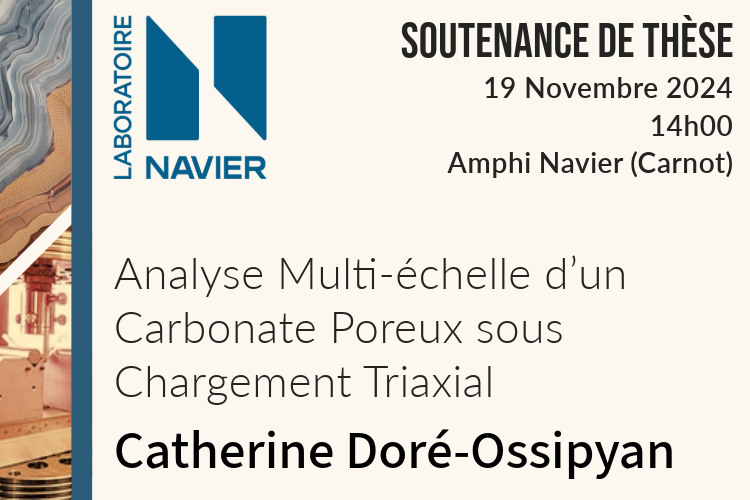
Soutenance de thèse – Catherine Doré-Ossipyan
- Post by: Mathias Lebihain
- 13 novembre 2024
- No Comment
Catherine Doré-Ossipyan, doctorante au sein des équipes Géotechnique et Multi-Échelle, soutiendra sa thèse « Analyse Multi-échelle d’un Carbonate Poreux sous Chargement Triaxial » le mardi 19 novembre à 14h dans l’amphithéâtre Cauchy.
Composition du jury :
-
Patrick Baud – Ecole et Observatoire des Sciences de la Terre – Rapporteur
-
Jérôme Fortin – Ecole Normale Supérieure – Rapporteur
-
Elisabeth Bemer – IFPEN – Examinatrice
-
Alexis Cartwright-Taylor – Heriott-Watt University – Examinatrice
-
Pierre Bésuelle – Laboratoire 3SR – Examinateur
-
Jean Sulem – École des Ponts – Directeur de thèse
-
Michel Bornert – École des Ponts – Co-encadrant de thèse
-
Alexandre Dimanov – IPP-X – Co-encadrant de thèse
Résumé de la thèse
Afficher le résumé
One of the solutions being considered for reducing emissions of greenhouse gases is their capture and geological sequestration. Porous carbonate rocks are considered excellent candidates due to their high capacity and permeability, but they are also inherently heterogeneous and multi-scale. Experimental and field studies carried out in the last two decades showed that, under multiaxial loading conditions, they accommodate deformation heterogeneously, which has an impact on porosity and its distribution, which in turn affects permeability. Carbonates present a very large microstructural variability when compared to sandstones, and a special attention has to be brought to the study of the link between microstructure and deformation modes.
In the present work, deformation modes are studied experimentally on a high porosity carbonate rock (38% on average), the Saint-Maximin limestone. This rock presents dense and porous zones which alternate at centimeter scale. An earlier study on 40mm diameter samples showed that the nucleation and propagation of bands is controlled by porosity heterogeneity at the centimeter scale. To understand the role of microstructure on observed band patterns, samples of 8 mm in diameter were cored in both types of zones, and their deformation modes were investigated by combining imaging techniques on evolving material at various loading conditions. A total of twelve samples were tested using a new in situ triaxial device, and imaged continuously using fast and highly-resolved synchrotron tomography (Psiché beamline, Soleil). 3D strain fields using Digital Volume Correlation, and porosity maps, both computed at the same gauge length are constructed. The entire strain and porosity evolutions for each subvolume is thus known. Global and local measures are analyzed to understand the scaling effects of microstructure on deformation modes. Both types of microstructures show brittle behavior at low confining pressure and ductile yielding at high confining pressure. Localized and diffuse deformation is shown to initiate in the most porous millimeter-sized zones. In addition, dense samples present a transitional behavior at intermediate confining pressures, linked to its heterogeneous microstructure. On the local scale, localized deformation is associated with homogenization around a critical value, where more porous zones compact, and denser zones dilate. Diffuse compaction at higher confining pressure acts as progressive densification until a homogeneous state is reached. Local yielding is shown to depend on initial porosity and post- yield behavior on the stress-path. This study provides a substantial amount of high-quality data on deformation modes in a heterogeneous porous carbonate rock, allowing to understand how local porosity controls global behavior at different scales and various loading conditions.


